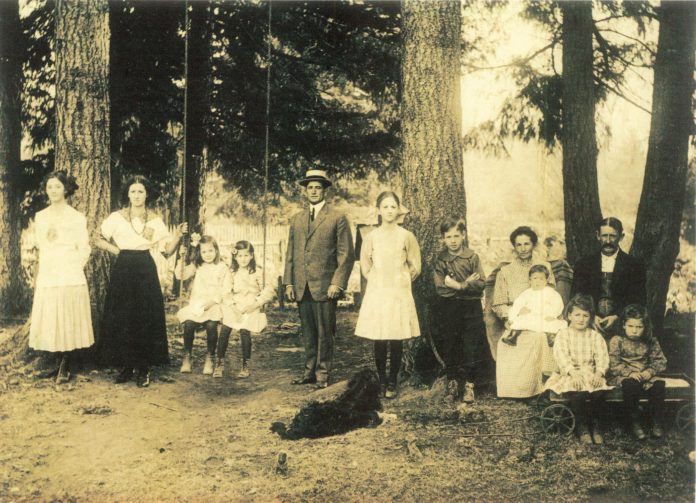Bayard Taylor Plass and his family gathered somewhere near Black Diamond when this photo was taken in 1911. At the time, B.T., as he called himself, was a dairy farmer attracted to the area 15 years earlier when coal mining boomed in Black Diamond. B.T. Plass and his wife, Margaret (Thompson) arrived in the Green River district about 1896. They came from Kansas by way of Oregon where they married. The Plass family from left to right included daughters, Bea, Frances, Margaret, and Helen (on swing), Uncle Will Thompson (in straw hat), Myrtle, oldest son, Howard (with folded arms), the mother, Margaret (or Maggie) holding the youngest, Russell, the father, Bayard, plus daughters, Beth and Katherine, called Kitty seated on a wagon.
In 1920, B.T. Plass signed a real estate contract to purchase 77 acres of timberland from Pacific Coast Coal Co. At the time the company was operating Black Diamond’s most successful vein, Mine #11, originally known as Morgan Slope. The opening was once the deepest underground coal mine in the United States reaching a depth of 2,000 feet beneath the surface or 1,400 feet below sea level. Operated from 1896 to 1927, Mine #11 regularly produced a quarter million tons per year, with total production over those 31 years of nearly 7 million tons. When Plass purchased his real estate, Pacific Coast’s Mine #11 was worked by 348 underground men, 147 outside, for a total of 495 employees.
But their employment numbers didn’t include contract loggers like B.T. Plass, who supplied mine props and lagging to local mines. In addition, B.T. Plass regularly sold railcar loads of alder firewood to dealers in the larger cities. An enterprising man, he also raised dairy cows and sold milk to local creameries. The property that Plass bought contained substantial amounts of timber including Douglas fir, alder, and cedar. Only fir was useful as props and support beams to hold up the roof of an underground mine. Eight-foot-long fir logs typically served as posts and beams in the gangway or main access tunnel of the mine. Six-foot props were mostly used in counter-ways and crosscuts where much of the actual mining took place. Plass was paid 12¢ per prop or 2¢ per lineal foot. Tougaw & Olson, a supplier out of Enumclaw was selling the same six-foot props for 9¢ each, delivered.
Price competition from competitors was fierce and Plass often fell behind on his real estate contract. He sometimes traded credits from timber props he supplied to Pacific Coast against payments due on his land purchase. In 1932, King County announced plans for a new Kummer cut-off road and bridge across the Green River, today known as S.R. 169. To facilitate the new highway, Pacific Coast Coal purchased a portion of the property back from B.T. Plass, providing him a boon of both cash with over 1,500 lineal feet of road frontage.
Tragedy struck the Plass family in Dec. 1919 when Bayard’s wife, Maggie died at age 52. Just over three years later, B.T.’s oldest son, Howard Plass was found dead at the bottom of a 200-foot cliff in the Green River Gorge. Howard had left his father’s home at 10:30 am on Sunday, Jan. 28, 1923 with plans to meet another youth and spear fish. His companion declined to go due to the heavy snow. When Howard failed to return that evening, B.T. Plass and neighbors searched the area’s trails, eventually finding his son’s body the following day. The remainder of Bayard’s children lived full lives, with Katherine (Tapella) the last to expire in 2007. Bayard Taylor Plass passed away in Black Diamond in 1957 at age 85, with 22 grandchildren and 11 great-grandchildren.
This photo comes courtesy of one of those great-grandchildren, Gina Vaughn, who is part-owner of the Smokehouse & More located next door to the Black Diamond Bakery. Genealogical research was provided by Donna Brathovde, an amateur family historian who does genealogical research and lives in Ravensdale.









